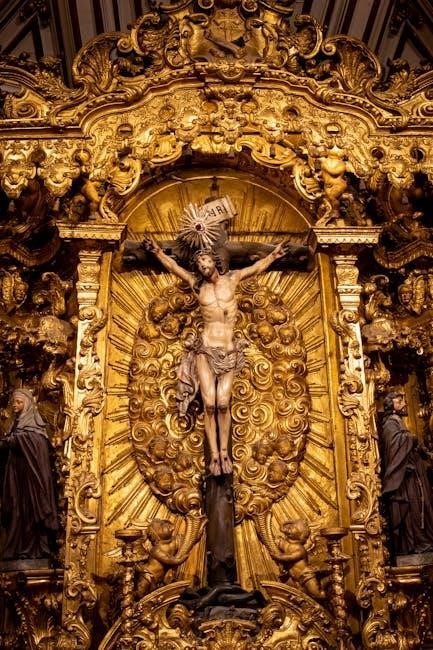The Hero with a Thousand Faces‚ by Joseph Campbell‚ explores universal mythological themes and the monomyth concept. Published in 1949‚ it remains influential in literature‚ film‚ and psychology‚ offering timeless insights into human experiences.
1.1 Overview of “The Hero with a Thousand Faces”

The Hero with a Thousand Faces is a seminal work by Joseph Campbell‚ first published in 1949‚ that explores the universal patterns found in myths and stories across cultures. The book introduces the concept of the monomyth‚ a shared narrative structure that underpins hero stories worldwide. Campbell identifies common stages in the hero’s journey‚ such as the call to adventure‚ supernatural aid‚ and the road of trials‚ which collectively form a psychological and spiritual framework. By analyzing myths from diverse traditions‚ Campbell reveals how these stories reflect fundamental human experiences and aspirations. The book bridges mythology‚ psychology‚ and literature‚ offering insights into the collective unconscious and the role of storytelling in shaping human understanding. Its third edition‚ part of Campbell’s collected works‚ features expanded illustrations and a comprehensive bibliography‚ making it a vital resource for scholars and enthusiasts alike.

1.2 Background of Author Joseph Campbell
Joseph Campbell‚ born in 1904 and passing in 1987‚ was a renowned American mythologist‚ writer‚ and lecturer. He earned degrees in literature and philosophy‚ developing a deep interest in comparative mythology and psychology. Campbell’s academic career included teaching at Sarah Lawrence College‚ where he inspired generations of students. His extensive research and travels exposed him to diverse mythological traditions‚ shaping his groundbreaking ideas. Campbell is best known for The Hero with a Thousand Faces‚ which introduced the monomyth concept‚ influencing fields from literature to film. His work often explored the intersection of mythology and human psychology‚ drawing on Carl Jung’s archetypes. Campbell’s later life saw collaborations with George Lucas and Bill Moyers‚ further popularizing his ideas. His legacy endures through his writings‚ including The Power of Myth series‚ cementing his role as a leading figure in modern mythological studies.
1.3 Publication History and Editions
The Hero with a Thousand Faces was first published in 1949 and has since become a seminal work in comparative mythology. The book’s third edition‚ released in 2020 as part of The Collected Works of Joseph Campbell‚ features expanded illustrations‚ a comprehensive bibliography‚ and more accessible sidebars. This edition ensures the work remains relevant for modern audiences. The book is widely available in various formats‚ including hardcover‚ paperback‚ and digital versions. A PDF version can be accessed through libraries or purchased online‚ making it easily accessible to readers worldwide. Notable editions include the 2008 commemorative edition and the 2020 Collected Works edition‚ both of which offer enhanced readability and additional scholarly content. The book’s enduring popularity has led to translations into multiple languages‚ further cementing its global influence. Its publication history reflects its timeless appeal‚ as it continues to inspire new generations of readers in fields such as literature‚ film‚ and psychology.

Structure of the Book
The Hero with a Thousand Faces is structured around the monomyth‚ dividing the hero’s journey into two main parts: Departure and Initiation. It explores stages like the call to adventure‚ trials‚ and atonement with the father.
2.1 The Monomyth Concept
The monomyth‚ a central idea in The Hero with a Thousand Faces‚ refers to the universal pattern of the hero’s journey found in myths worldwide. Joseph Campbell identifies this archetype as a shared human experience‚ transcending cultural boundaries. The monomyth is divided into stages‚ beginning with the hero’s ordinary world‚ a call to adventure‚ and a reluctant acceptance of the challenge. This is followed by supernatural aid‚ crossing the threshold into an extraordinary realm‚ and facing trials that test the hero’s resolve. The concept emphasizes the psychological and symbolic significance of these stages‚ reflecting inner transformations and universal truths. Campbell draws parallels between myths from diverse cultures‚ such as Greek‚ Native American‚ and Hindu traditions‚ to illustrate the monomyth’s consistency; This framework has become a foundational tool for understanding storytelling and its resonance with human psychology‚ influencing fields like literature‚ film‚ and anthropology. The monomyth remains a powerful metaphor for personal growth and the collective unconscious.
2.2 Key Chapters and Sections
The Hero with a Thousand Faces is structured into key chapters and sections that explore the monomyth in depth. The book begins with a prologue introducing the concept of the monomyth‚ followed by sections on “Myth and Dream‚” “Tragedy and Comedy‚” and “The Hero and the God.” Part I‚ “The Adventure of the Hero‚” is divided into two main chapters: “Departure” and “Initiation.” These chapters detail the stages of the hero’s journey‚ including “The Call to Adventure‚” “Refusal of the Call‚” “Supernatural Aid‚” and “The Crossing of the First Threshold.” Chapter II‚ “Initiation‚” explores trials‚ meetings with goddesses‚ and the hero’s atonement with the father. The book also includes a section titled “The World Navel‚” which examines the symbolic center of the hero’s journey. The third edition features expanded illustrations‚ sidebars‚ and a comprehensive bibliography‚ enhancing the reader’s understanding of Campbell’s groundbreaking work. These sections collectively provide a rich framework for analyzing myths and their universal appeal.

The Hero’s Journey
The Hero’s Journey‚ a transformative path‚ includes stages like the Call to Adventure‚ Refusal‚ Supernatural Aid‚ and Crossing the First Threshold. These universal steps symbolize psychological growth and self-discovery‚ resonating deeply across cultures.
3.1 Stages of the Monomyth
The monomyth‚ as outlined in The Hero with a Thousand Faces‚ follows a universal pattern of transformation. It begins with the Call to Adventure‚ where the hero is summoned to embark on a journey. This is often followed by the Refusal of the Call‚ as the hero hesitates or fears the unknown. Supernatural Aid then intervenes‚ providing guidance or tools for the quest. The hero must cross the First Threshold‚ leaving the ordinary world behind. They then enter the Belly of the Whale‚ a symbolic death and rebirth. The Road of Trials tests the hero’s resolve through challenges and temptations. The Meeting with the Goddess represents a divine or romantic encounter‚ while Woman as the Temptress symbolizes seduction or distraction. The journey culminates in Atonement with the Father‚ where the hero confronts a great power or their own fears‚ leading to Apotheosis‚ or spiritual enlightenment. These stages create a timeless framework for understanding heroic transformation.
3.2 Mythological Examples
Joseph Campbell illustrates the monomyth through diverse mythological figures‚ showcasing its universal appeal. Odysseus from Greek mythology exemplifies the hero’s journey‚ facing trials like the sirens and Cyclops; Similarly‚ Buddha embodies the monomyth‚ renouncing worldly life to seek enlightenment. Moses‚ leading the Israelites out of Egypt‚ mirrors the hero’s transformative quest. These stories highlight the monomyth’s recurring themes: the call to adventure‚ trials‚ and ultimate triumph. Campbell’s analysis reveals how these narratives‚ despite cultural differences‚ share a common structure. By comparing myths from various traditions‚ he demonstrates the unity of human storytelling. These examples not only validate the monomyth but also show its enduring relevance across time and cultures‚ making The Hero with a Thousand Faces a foundational work in comparative mythology and storytelling studies.

Impact on Literature and Film
The Hero with a Thousand Faces deeply influences literature and film‚ inspiring works like Star Wars and guiding screenwriters. Its concepts remain vital in storytelling‚ shaping modern narratives across genres.
4.1 Influence on Literature
Joseph Campbell’s The Hero with a Thousand Faces has profoundly shaped modern literature‚ inspiring authors to incorporate the monomyth into their narratives. Writers like George Lucas and Christopher Vogler adapted its principles‚ creating iconic stories. The book’s exploration of archetypes and universal themes has influenced genres from fantasy to science fiction. Many authors use Campbell’s framework to craft compelling protagonists and structured plots. Its insights into comparative mythology have also enriched literary analysis‚ helping scholars and readers understand deeper symbolic meanings. The monomyth’s relevance continues to grow‚ making it a cornerstone of literary studies and creative writing. Campbell’s work remains a vital resource for understanding storytelling’s universal appeal and its application in literature.
4.2 Role in Screenwriting and Film
Joseph Campbell’s The Hero with a Thousand Faces has had a profound impact on screenwriting and film‚ particularly through its concept of the monomyth. Filmmakers like George Lucas and Christopher Vogler have openly credited Campbell’s work as a foundation for crafting compelling narratives. The monomyth’s structured stages‚ such as the “Call to Adventure” and “Return with the Elixir‚” provide a universal framework for storytelling that resonates with audiences worldwide. Movies like Star Wars and The Lion King exemplify this influence‚ as their protagonists embody the archetypal hero’s journey. The book’s insights into mythological themes have become a cornerstone of screenwriting education‚ helping creators develop relatable characters and emotionally engaging plots. Its principles continue to inspire filmmakers‚ ensuring its relevance in modern cinema and beyond.

Psychological Insights
The Hero with a Thousand Faces explores the psychological depth of mythological themes‚ blending modern psychology with universal archetypes. It delves into Carl Jung’s concept of the collective unconscious‚ revealing how myths reflect human experiences and emotional struggles‚ offering insights into personal growth and transformation.
5.1 Jungian Archetypes
Joseph Campbell’s The Hero with a Thousand Faces deeply explores Jungian archetypes‚ drawing from Carl Jung’s concept of the collective unconscious. These universal symbols and characters‚ such as the Hero‚ Mentor‚ and Temptress‚ appear across cultures and time‚ reflecting shared human experiences. Campbell demonstrates how these archetypes are central to the monomyth‚ the universal narrative pattern he identifies. The Hero archetype‚ for instance‚ embodies the journey of self-discovery and transformation‚ while the Shadow represents the repressed aspects of the psyche. By aligning mythological themes with psychological principles‚ Campbell bridges the gap between ancient stories and modern understanding‚ showing how archetypes continue to resonate in contemporary literature‚ film‚ and personal growth. This integration of Jungian theory into comparative mythology highlights the timeless relevance of archetypal imagery in shaping human storytelling and self-perception.
5.2 Modern Psychological Applications
Joseph Campbell’s The Hero with a Thousand Faces has found profound applications in modern psychology‚ particularly in understanding personal growth and transformation. The monomyth’s stages‚ such as the call to adventure and the road of trials‚ resonate with individuals facing life challenges‚ offering a narrative structure for self-reflection and healing. Psychologists often use the hero’s journey as a metaphor for overcoming adversity‚ fostering resilience‚ and achieving emotional balance. The concept of the “ordinary world” and the “special world” aligns with therapeutic practices that help individuals transition through significant life changes. Additionally‚ the book’s emphasis on universal archetypes connects with modern theories of identity and purpose‚ making it a valuable tool in counseling and personal development. Its insights continue to inspire contemporary approaches to mental health‚ stress management‚ and the pursuit of meaningful life goals.

Availability and Editions
The Hero with a Thousand Faces is widely available in various editions‚ including a third edition with expanded illustrations and a comprehensive bibliography. The PDF version can be accessed through libraries or purchased online‚ offering readers a convenient way to explore Campbell’s seminal work.
6.1 Accessing the PDF Version
Accessing the PDF version of The Hero with a Thousand Faces is convenient for modern readers. The book is available through various online platforms‚ including libraries and e-book retailers. Many local libraries offer free access to the PDF version with a library card‚ making it easily accessible without purchase. Additionally‚ the third edition‚ part of the Collected Works of Joseph Campbell‚ features expanded illustrations and a comprehensive bibliography‚ enhancing the reader’s experience. For those preferring ownership‚ the PDF can be purchased from online retailers like Amazon or downloaded from platforms like Internet Archive. This digital format allows readers to explore Campbell’s seminal work on comparative mythology and the monomyth concept with ease‚ ensuring its timeless insights remain accessible to new generations of scholars and enthusiasts alike.
6.2 Notable Editions and Features
The third edition of The Hero with a Thousand Faces‚ part of the Collected Works of Joseph Campbell‚ stands out for its enhanced features. It includes expanded illustrations‚ a comprehensive bibliography‚ and more accessible sidebars‚ making it a valuable resource for scholars and enthusiasts. The 2020 Collected Works Edition offers a refreshed design‚ ensuring the book remains relevant for modern audiences. Additionally‚ the original 1949 edition is still celebrated for its groundbreaking introduction of the monomyth concept. Digital versions‚ including the PDF‚ retain these features while offering portability and ease of access. The book’s timeless insights into comparative mythology and psychology are preserved across all editions‚ ensuring its continued influence in fields like literature‚ film‚ and anthropology. Whether in print or digital format‚ The Hero with a Thousand Faces remains a seminal work‚ bridging ancient myths with contemporary understanding.

Cultural and Academic Relevance
The Hero with a Thousand Faces bridges anthropology‚ psychology‚ and religious studies‚ offering insights into universal myths. Its interdisciplinary approach makes it a cornerstone in cultural and academic discourse‚ enduringly relevant across fields.
7.1 Role in Anthropology
The Hero with a Thousand Faces has profoundly influenced anthropology by providing a framework to understand universal mythological patterns across cultures. Joseph Campbell’s concept of the monomyth reveals shared human experiences‚ highlighting the similarities in heroic narratives worldwide. This approach has enabled anthropologists to explore the cultural and symbolic meanings embedded in myths‚ offering insights into societal structures‚ beliefs‚ and values. By examining the archetypal journey of the hero‚ the book bridges the gap between psychology and anthropology‚ demonstrating how myths reflect collective unconscious themes. Its interdisciplinary perspective has made it a foundational text in comparative mythology and cultural studies. The book’s emphasis on the unity of human storytelling has inspired anthropological research into ritual‚ symbolism‚ and the role of myths in shaping identities. As a result‚ The Hero with a Thousand Faces remains a vital resource for understanding the cultural and symbolic dimensions of human societies.
7.2 Significance in Religious Studies
The Hero with a Thousand Faces holds profound significance in religious studies by illuminating the universal themes and archetypes present in sacred narratives. Joseph Campbell’s monomyth concept reveals the shared spiritual journeys of religious figures‚ such as Buddha‚ Jesus‚ and Muhammad‚ highlighting the common quest for transcendence and divine connection. The book demonstrates how myths and religious stories serve as symbolic guides for individuals seeking enlightenment or salvation. By exploring the hero’s journey‚ Campbell bridges psychology and theology‚ showing how religious narratives reflect deeper human aspirations and existential questions. This framework has inspired scholars to analyze religious texts through the lens of comparative mythology‚ uncovering the unity of spiritual experiences across cultures. The Hero with a Thousand Faces thus remains a cornerstone in understanding the role of religion in shaping human identity and the eternal quest for meaning. Its insights continue to enrich religious studies‚ offering a bridge between faith and universal human experiences.
The Hero with a Thousand Faces remains a timeless exploration of universal myths. Its PDF availability ensures accessibility‚ while its insights continue to inspire fields like literature‚ film‚ and psychology‚ cementing its legacy.
8.1 Legacy of the Book
The Hero with a Thousand Faces has left an indelible mark on modern thought‚ transcending academia to influence literature‚ film‚ and psychology. Its introduction of the monomyth concept revolutionized storytelling‚ offering a universal framework for understanding hero narratives. The book’s PDF versions ensure accessibility‚ allowing new generations to explore its insights. Joseph Campbell’s work has inspired countless authors‚ filmmakers‚ and scholars‚ embedding its ideas into popular culture. The monomyth’s stages‚ such as the call to adventure and the hero’s return‚ are now foundational in screenwriting and narrative design. Its exploration of Jungian archetypes resonates deeply‚ linking mythology to human psychology. As a result‚ the book remains a cornerstone in comparative mythology and cultural studies‚ continuing to inspire fresh interpretations and applications. Its legacy endures as a testament to the power of myth in shaping human understanding and creativity.
8.2 Continued Influence and Relevance
The Hero with a Thousand Faces remains a cornerstone of modern intellectual and cultural discourse‚ its influence undiminished since its publication. The book’s PDF versions have ensured its accessibility‚ allowing it to reach new audiences in the digital age. Its concepts‚ particularly the monomyth‚ continue to inspire creators in film‚ literature‚ and beyond. Screenwriters and authors worldwide draw on Campbell’s framework to craft compelling narratives‚ while psychologists and educators use it to explore human behavior and cultural patterns. The book’s integration of mythology‚ psychology‚ and philosophy provides a holistic understanding of the human experience‚ making it a vital resource in academic and religious studies. Its relevance extends to contemporary issues‚ offering insights into personal growth and societal transformation. As a result‚ The Hero with a Thousand Faces continues to shape both creative and intellectual landscapes‚ ensuring its enduring legacy in the 21st century and beyond.

